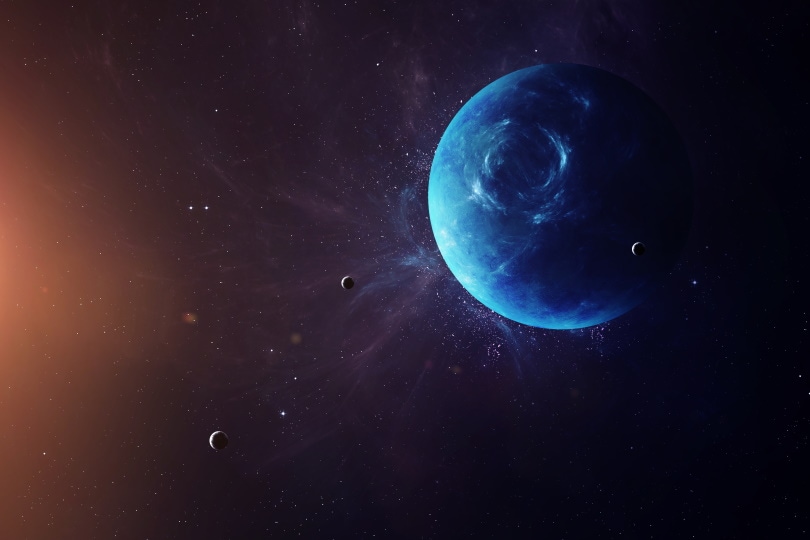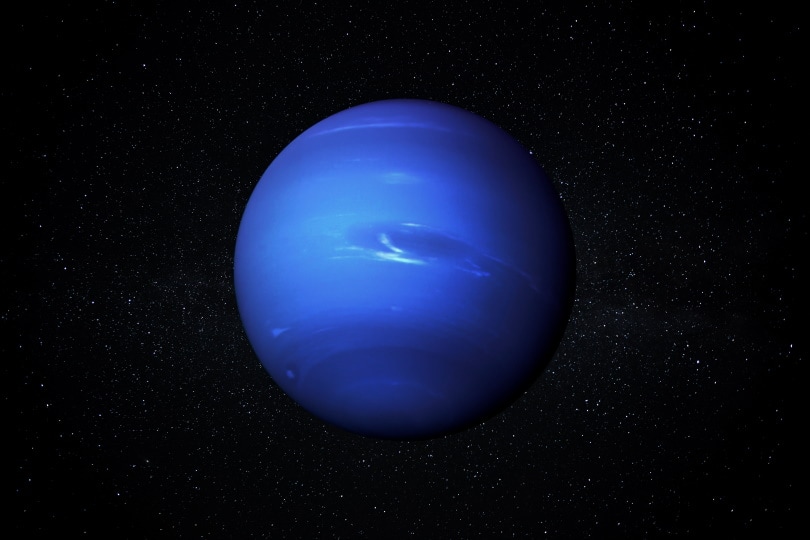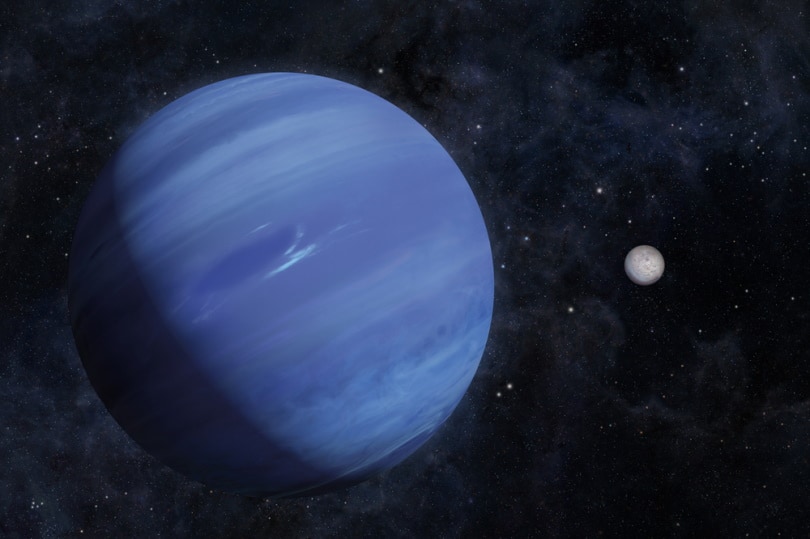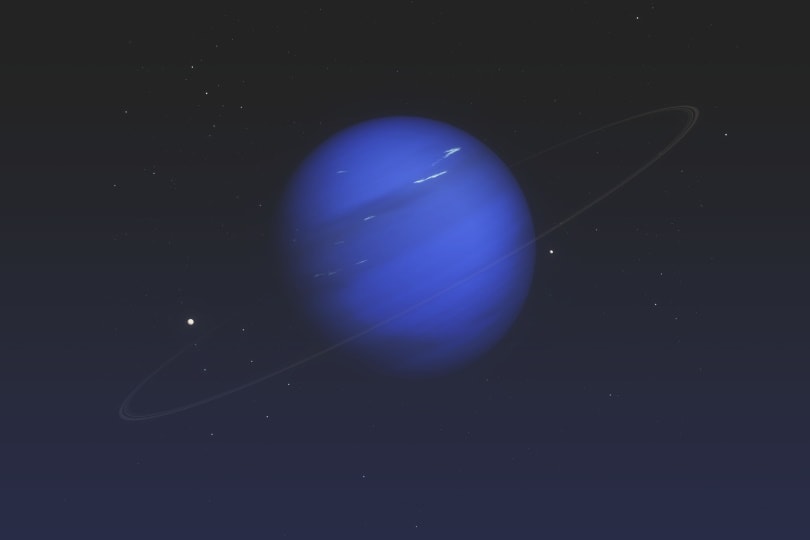Why Is Neptune Blue? The Surprising Answer!
Last Updated on

Neptune is the furthest planet in our solar system and an ice giant named after the Roman god of the sea. The planet’s astronomical symbol ♆ represents Neptune’s trident, which is the classical weapon of the mythological sea god. It’s only fitting that Neptune appeals to its namesake, sporting a vibrant azure color that is completely enthralling.
At a glance, Neptune may appear to be a peaceful ocean world. However, it is anything but. Neptune sports some of the most intense weather systems in the solar system, with violent, ferocious winds and extremely frigid temperatures. The reason behind Neptune’s brilliant color is quite surprising, so keep reading to find out why!

Neptune’s Vibrant Color
Neptune’s brilliant color is due to its gaseous atmosphere, which contains substances such as hydrogen, helium, and methane. The methane content of the atmosphere is primarily responsible for the planet’s unique hue, and the science behind it is relatively simple. When sunlight hits the methane in Neptune’s atmosphere, the longer red wavelengths of light get absorbed, while the comparatively shorter blue wavelengths get reflected back into space. Despite making up only about 1% of Neptune’s atmosphere, methane is the most critical compound influencing the planet’s color.

The Electromagnetic and Visible Light Spectrums
White light is formed from a combination of all the colors found in visible light, which only makes up a small sliver of the electromagnetic spectrum. Each color is associated with a different wavelength, with the shorter blue and violet wavelengths on one end and the longest red wavelengths on the other. When we look at an object, it appears to be a specific color due to how it reflects and absorbs wavelengths of light. For example, a Red Delicious apple appears to be red because it reflects red light while absorbing blue and green light.
This is the same case for Neptune, which has methane clouds that absorb low-frequency wavelengths of light that fall in the range of 620 to 750 nanometers. On the electromagnetic spectrum, this range of wavelengths corresponds to red light, which is why red light seems “filtered out” when we look at Neptune. However, methane is also really good at reflecting short, high-energy wavelengths between 450 and 495 nanometers. This range of wavelengths corresponds to blue light, which is bounced off the planet to create the beautiful azure color Neptune is known for. Essentially, when we look at Neptune, we see sunlight reflect off the planet with the red component filtered out.

The Discovery of Neptune
When Johann Galle first discovered Neptune in 1846, astronomers had no idea what the planet even looked like. Neptune was the first planet to be discovered by mathematical prediction, and Galle only knew where to look based on previous predictions made by mathematician Urbain Le Verrier. It was by a pure stroke of luck that Neptune was given its name, which is synonymous with the sea and its deep blue color. Scientists only discovered Neptune’s unique color when NASA’s Voyager 2 spacecraft flew by the planet in 1989. At this moment, Voyager sent back the pictures of Neptune’s ocean-like hue for the first time. In addition, Voyager 2 discovered five of Neptune’s moons, four planetary rings, and a ferocious storm dubbed the “Great Dark Spot,” making Neptune a planet of extreme scientific interest.

Returning to Neptune
Plans to return to Neptune’s icy domain have been on NASA’s to-do list for well over a decade. Out of all the planets in the solar system, we know the least about the ice giants, with no spacecraft getting close to them since Voyager 2’s flyby in 1989. One of the most significant problems the space exploration community faces is which ice giant to visit, which impedes plans to visit their cosmic neighborhood. However, Neptune’s largest moon, Triton, may be the tiebreaker necessary for a return to this fascinating planet.
When Voyager 2 did a flyby of Triton decades ago, it observed peculiar plumes extending over 26,000 feet above the moon’s south pole. It turned out that these plumes were actually geysers expelling vaporized nitrogen with volcanic force. This was due to solar radiation heating a thin layer of nitrogen ice on Triton’s surface, which is an area of major scientific interest. However, the south pole of Triton is estimated to go into darkness in 2049, which could make these plumes invisible to spacecraft. Triton is also the only major moon in our solar system that follows a retrograde orbit, which helps Neptune’s case even more. By sending a mission to Neptune, we would be able to kill two birds with one stone and take a closer look at Triton’s unique behavior while learning more about Neptune.

A primary mission concept that has been proposed in recent years is Neptune Odyssey, an orbiter and atmospheric probe pair similar to NASA’s Cassini mission to Saturn. During its estimated four-year mission, Neptune Odyssey would perform several fly-bys of Triton and study Neptune’s rings, moons, aurora, and cosmic neighborhood before performing a deathly dive into Neptune’s atmosphere. The proposed launch date for Neptune Odyssey is in 2031, when it would launch aboard NASA’s Space Launch System. After successful insertion, the spacecraft is set to get a gravity assist from Jupiter and then cruise for 12 years before arriving at Neptune in 2043.

Summary
Neptune is a fascinating planet with many mysteries waiting to be unraveled. Its deep, azure blue color is one of its characterizing features and is mainly due to the methane in its atmosphere. However, other planets, like Uranus, are lighter and more blue-green in color due to a particular chromophore in their atmosphere. As this compound has yet to be identified, the true origin of Neptune’s vibrant color remains largely unknown.
Featured Image Credit: Vadim Sadovski, Shutterstock
About the Author Laura Guziczek
Laura Guziczek is from New York City and an aerospace engineer by day, freelance writer by night. Although she is always moving around, Laura is currently based on Florida's sunny Space Coast, where she attends graduate school. Her passions and hobbies include astrodynamics, rocketry, spaceflight, planetary science, cooking, music, and art, making her a great fit here at OpticsMag! When she's not working, you can frequently find her traveling, honing her cooking skills, thinking about space too much, and hanging out with her friends and dogs.
Related Articles:
What Is the Best Binocular Magnification for Hunting? Optical Features Explained
15 Crucial Facts About Ultraviolet Rays & the Sun
What Constellation Is Spica In? The Interesting Answer!
10 Interesting Leo Constellation Facts, Myths, and FAQs
15 Interesting Pegasus Constellation Facts, Myths, and FAQs
6 Interesting Sagittarius Constellation Facts, Myths, and FAQs in 2024!
What Are Constellations? Where Did They Come From?
8 Interesting Libra Constellation Facts, Myths, and FAQs
